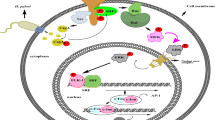Abstract
The molecular mechanisms leading to gastric carcinogenesis still remain unclear. Recently, several studies demonstrated that over-expression of guanylyl cyclase C (GCC) has been detected in intestinal-type gastric cancer (GC) and precursor lesions. Our objective was to explore the expression levels of GCC and endogenous ligands guanylin (GN) and uroguanylin (UGN) and the correlation between Helicobacter pylori (H. pylori) and GCC, GN, and UGN expressions in patients at different stages from normal mucosa to superficial gastritis, atrophic gastritis, intestinal metaplasia (IM), dysplasia, and finally adenocarcinoma. The expression of GCC and GN was absent in the distal normal gastric tissues and superficial gastritis in all cases, whereas they were measured in IM, dysplasia, and GC. The expression of GCC and GN was closely related to intestinal-type GC. From superficial gastritis to gastric carcinomas, the H. pylori positive rate was 19.7, 33.3, 69.6, 80.0, and 82.1%, respectively. The positive correlation was found between GCC and GN in IM, dysplasia, and GC. Also, the positive correlation was found between GCC, GN, and H. pylori infection in them. These results demonstrate that the detection of GCC and GN will be beneficial to diagnosis human gastric carcinoma and precancerous lesions. Ectopic expression of GCC and GN in human gastric mucosa and H. pylori infection may play an important role in the carcinogenesis of the intestinal-type GC.







Similar content being viewed by others
References
Ebert MP, Malfertheiner P. Pathogenesis of sporadic and familial gastric cancer-implications for clinical management and cancer prevention. Aliment Pharmacol Ther. 2002;16:1059–66.
Leung WK, Wu MS, Kakugawa Y, et al. Screening for gastric cancer in Asia: current evidence and practice. Lancet Oncol. 2008;9:279–87.
Yuasa N, Nimura Y. Survival after surgical treatment of early gastric cancer, surgical techniques and long-term survival. Langenbecks Arch Surg. 2005;390:286–93.
Jones PA, Baylin SB. The epigenomics of cancer. Cell. 2007;128:683–92.
Dunn BE, Cohen H, Blaser MJ. Helicobacter pylori. Clin Microbiol Rev. 1997;10:720–41.
Kusters JG, van Vliet AH, Kuipers EJ. Pathogenesis of Helicobacter pylori infection. Clin Microbiol Rev. 2006;19:449–90.
Correa P. Helicobacter pylori and gastric carcinogenesis. Am J Surg Pathol. 1995;19:537–43.
Atherton JC. The clinical relevance of strain types of Helicobacter pylori. Gut. 1997;40:701–3.
Cohen MB, Hawkins JA, Witte DP. Guanylin mRNA expression in human intestine and colorectal adenocarcinoma. Lab Invest. 1998;78(1):101–8
Sindic A, Schlatter E. Cellular effects of guanylin and uroguanylin[J]. J Am Soc Nephrol. 2006;17:607–16.
Basu N, Arshad N, Visweswariah SS. Receptor guanylyl cyclase C (GC-C): regulation and signal transduction[J]. Mol Cell Biochem. 2010;334:67–80.
Livak KJ, Schmittgen TD. Analysis of relative gene expression data using real-time quantitative PCR and the 2(-Delta Delta C(T)) method. Methods. 2001;25:402–8.
Ding WJ, Fang JY, Chen XY, et al. The expression and clinical significance of DNA methyltransferase proteins in human gastric cancer. Dig Dis Sci. 2008;53:2083–9.
Mao ZB, Zhang JF, Xu Z, et al. Ectopic expression of guanylyl cyclase C in gastric cancer as a potential biomarker and therapeutic target. J Dig Dis. 2009;10:272–85.
Israel DA, Peek RM. Pathogenesis of Helicobacter pylori-induced gastric inflammation. Aliment Pharmacol Ther. 2001;15:1271–90.
Rugge M, Genta RM. Staging and grading of chronic gastritis. Hum Pathol. 2005;36:228–33.
Vinagre RM, Corvelo TC, Arnaud VC, et al. Determination of strains of Helicobacter pylori and of polymorphism in the interleukin-8 gene in patients with stomach cancer. Arq Gastroenterol. 2011;48:46–51.
Wang J, Chi DS, Kalin GB, et al. Helicobacter pylori infection and oncogene expressions in gastric carcinoma and its precursor lesions. Dig Dis Sci. 2002;47:107–13.
Bornschein J, Kandulski A, Selgrad M, et al. From gastric inflammation to gastric cancer. Dig Dis. 2010;28:609–14.
Park J, Schulz S, Haaf J, et al. Ectopic expression of guanylyl cyclase C in adenocarcinomas of the esophagus and stomach. Cancer Epidemiol Biomarkers Prev. 2002;11:739–44.
Birbe R, Palazzo JP, Walters R, et al. Guanylyl cyclase C is a marker of intestinal metaplasia, dysplasia, and adenocarcinomas of the gastrointestinal tract. Hum Pathol. 2005;36:170–9.
Hofmann F, Bernhard D, Lukowski R, et al. cGMP regulated protein kinases (cGK). Handb Exp Pharmacol. 2009;191:137–62.
Mumtaz K, Abid S, Yakoob J, et al. An office-based serological test for detection of current Helicobacter pylori infection: is it useful? Eur J Gastroenterol Hepatol. 2006;18:85–8.
Lauwers GY. Defining the pathologic diagnosis of metaplasia, atrophy, dysplasia, and gastric adenocarcinoma. J Clin Gastroenterol. 2003;36:S37–43.
El-Zimaity HM, Ramchatesingh J, Saeed MA, et al. Gastric intestinal metaplasia: subtypes and natural history. J Clin Pathol. 2001;54:679–83.
Uemura N, Okamoto S, Yamamoto S, et al. Helicobacter pylori infection and the development of gastric cancer. N Engl J Med. 2001;345:784–9.
Dinis-Ribeiro M, Lopes C, da Costa-Pereira A, et al. A follow up model for patients with atrophic chronic gastritis and intestinal metaplasia. J Clin Pathol. 2004;57:177–82.
Mann EA, Jump ML, Glenella RA. Cell line-specific transcriptional activation of the promoter of the human guanylyl cyclase C/heat-stable enterotoxin/receptor gene. Biochim Biophys Acta. 1996;1305:7–10.
Swenson ES, Mann EA, Jump ML, et al. Hepatocyte nuclear factor-4 regulates intestinal expression of the guanylin/heat-stable toxin receptor. Am J Physiol. 1999;276:G728–36.
Park J, Schulz S, Waldman SA. Intestine-specific activity of the human guanylyl cyclase C promoter is regulated by Cdx2. Gastroenterology. 2000;119:89–96.
Debruyne PR, Witek M, Gong L, et al. Bile acids induce ectopic expression of intestinal guanylyl cyclase C Through nuclear factor-kappa B and Cdx2 in human esophageal cells. Gastroenterology. 2006;130:1191–206.
Acknowledgments
This work was supported by the Social Development Foundation of Nantong City (No.S2008015), Technologies Research and Development Program of Affiliated Hospital of Nantong University (Tdfy0906).
Conflict of interest
Authors declare that no conflicting or competing interests, of any nature, exist between the authors of this work and their academic activity.
Author information
Authors and Affiliations
Corresponding author
Rights and permissions
About this article
Cite this article
Zhang, JF., Mao, ZB., Li, ZL. et al. Ectopic expression of guanylyl cyclase C and endogenous ligand guanylin correlates significantly with Helicobacter pylori infection in gastric carcinogenesis. Med Oncol 29, 1748–1757 (2012). https://doi.org/10.1007/s12032-011-0067-x
Received:
Accepted:
Published:
Issue Date:
DOI: https://doi.org/10.1007/s12032-011-0067-x




